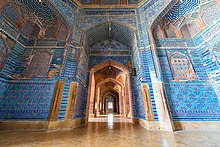Shah Jahan Mosque, Thatta
| Shah Jahan Mosque | |
|---|---|
شاہ جہاں مسجد | |
Timurid, Mughal | |
| Completed | 1659 |
| Specifications | |
| Dome(s) | 93 |
| Materials | Red bricks and tiles |
The Shah Jahan Mosque (
Location
The mosque is located in eastern
Background

Shah Jahan sought refuge in Thatta from his father Emperor Jahangir, after he had rebelled against his father.[4] Shah Jahan was impressed by the hospitality he received by the Sindhi people, and ordered construction of the mosque as a token of gratitude.[1][5] Construction of the mosque may have also been partially motivated by a desire to help alleviate the effects of a devastating storm that impacted the region in 1637,[3] and which had nearly destroyed Thatta.[1]
Shah Jahan's campaigns in Central Asia during this era influenced the mosque's architectural style, as Timurid influences were introduced into the Mughal Empire as his armies pressed towards Samarkand, in modern-day Uzbekistan.[1] Despite the fact that the Emperor was not in the region during its construction, and so was unlikely directly involved in its construction, its profuse tile-work and intricate brick work indicate that it was funded by the Mughal's imperial coffers.[3]
History

Persian inscriptions at the mosque indicated that it was built between 1644 and 1647,[3] during the reign of Mughal Emperor Shah Jahan. An eastern addition was completed in 1659,[6] during the reign of Emperor Aurangzeb.
The mosque's mihrab had initially been incorrectly aligned with
Architecture
The Shah Jahan Mosque's architectural style is overtly influenced by Turkic and Persian styles.[8] The mosque is characterized by extensive brickwork and the use of blue tiles, both of which were directly influenced by Timurid architectural styles from Central Asia[3][1] − from where the previous rulers of Sindh, the Tarkhans, had hailed before the region was annexed by the Mughals in 1592.[3]
Decorative elements
Tile work
The profuse use of tiles is considered to be the most elaborate display of tile work in the
The mosque's tiles represent a direct influence of the Timurid style.[1] The mosque employs cobalt blue, turquoise, manganese violet, and white tiles.
The mosque's dome is embellished with exquisite blue and white tile-work arranged in
The tiles' location and arrangement displays Persian
Brick work
The mosque features extensive brickwork laid in geometric patterns, which is a decorative element unusual for Mughal era mosques,[3] and is an element of Timurid architecture adopted for use in the mosque.[3] The mosque's brickwork was also influenced by Sindhi vernacular styles, which in turn was influenced by Persian architecture.[3] Brick work is most notable in the arcades surrounding the central courtyard, while concentric rings of brick are used to embellish the underside of peripheral domes.
Layout
The layout of the mosque may have been influenced by the conservative Timurid-style Humayun Mosque in Kachhpura, near the city of Agra,[3] in modern-day India. The main entryway into the mosque complex is through a Persian-style charbagh, or quadrangle garden.
It has a
The mosque's
The mosque is unusual for its lack of minarets. It has a total of 93 domes, the most of any structure in Pakistan.[10]
Conservation
Restoration works were carried out by Emperor Aurangzeb in 1692, as well as by Murad Ali Khan Talpur in 1812.[11] The mosque was inscribed on the tentative UNESCO World Heritage list in 1993,[12] but has not been conserved to the same high standards as the Wazir Khan Mosque or Badshahi Mosque in northern Pakistan.[10]
Gallery
-
The mosque’s mihrab
-
Arcades around the central courtyard feature bricks laid in geometric patterns
-
A close up view of mosque's geometric brickwork.
-
Some peripheral domes feature colored tiles as well as brick
-
Arches off of the central prayer chamber are decorated with blue Sindhi tiles
-
View from the gardens
-
A view of the mosque's courtyard
-
Pillar relief corner
-
The mosque's iwans, or entry portals, are also decorated with tile work.
Further reading
- Khan, Ahmed Nabi and Robert Wheeler. Islamic Architecture in South Asia, Oxford: Oxford University Press, 2003.
- Lari, Yasmeen. Traditional Architecture of Thatta, Karachi: Heritage Foundation, 1989.
- Mumtaz, Kamil Khan. Architecture in Pakistan, Singapore: Concept Media Pte Ltd, 1985.
- Nadiem, Ihsan H. Historic Mosques of Lahore, Lahore: Sang-e-Meel Publications, 1998.
- Nadiem, Ihsan H. Makli : The Necropolis at Thatta, Lahore: Sang-e-Meel Publications, 2000.
See also
- Wazir Khan Mosque - another Shah Jahan period mosque. Located in Lahore, the mosque is considered to be the most elaborately decorated Mughal mosque.
- List of mosques in Pakistan
References
- ^ ISBN 9780520279070. Retrieved 16 July 2017.
- ^ a b c d e "Shah Jahan Mosque, Thatta". UNESCO. UNESCO. Retrieved 17 July 2017.
- ^ ISBN 9780521267281. Retrieved 16 July 2017.
- ISBN 9781317588979.
- ^ Lari, Yasmeen (1989). Traditional architecture of Thatta. Heritage Foundation.
- ISBN 9780195790658.
- ^ ISBN 9781134370061. Retrieved 16 July 2017.
- ISBN 9780679604051.
- ISBN 9789695290101. Retrieved 16 July 2017.
- ^ a b c "Shahjahan Mosque: Thatta's timeless splendour". Dawn. Retrieved 17 July 2017.
- ^ "Shah Jahan Mosque, Thatta, Pakistan". Asian Historical Architecture.
- ^ "Shah Jahan Mosque, Thatta". UNESCO World Heritage Centre. Retrieved 2013-12-07.














